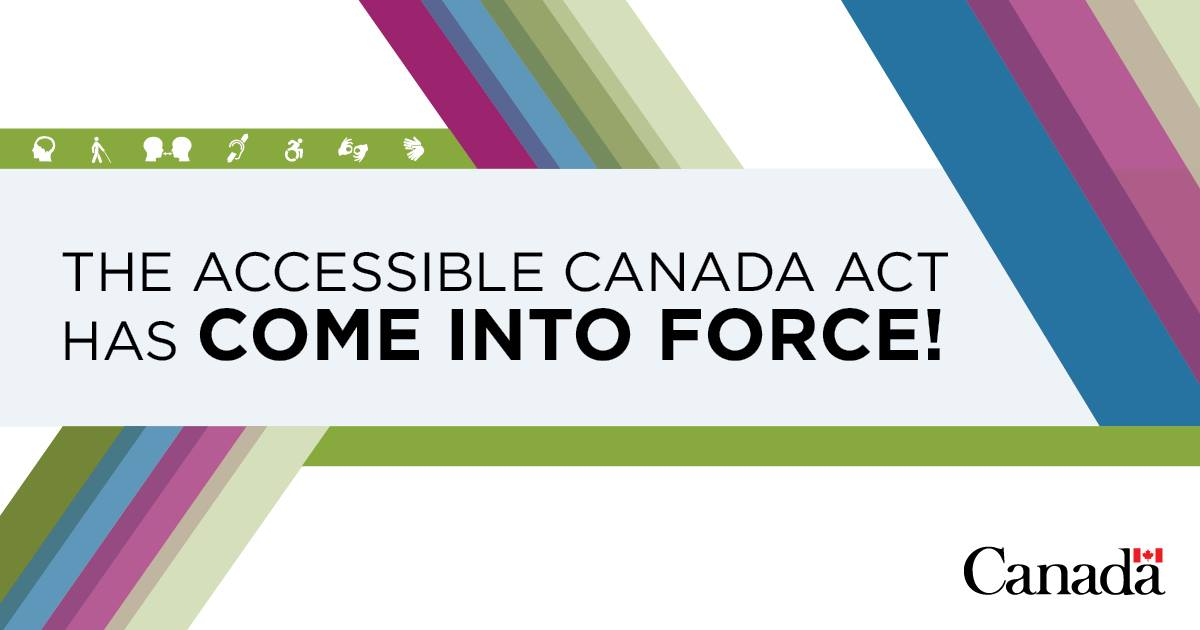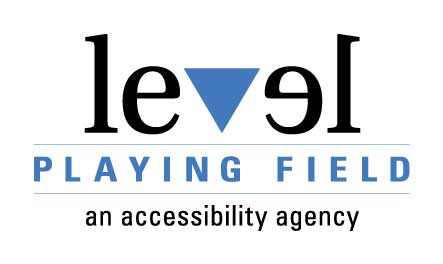ACCESSIBILITY LEGISLATION
What does an Accessible Canada mean to you?

LPF is happy to be involved in the Canadian Government’s Accessible Canada Project.

July 11, 2019 Gatineau, Quebec Employment and Social Development Canada
Accessibility in Canada is about creating communities, workplaces and services that enable everyone to participate fully in society without barriers. The Government of Canada believes that all Canadians deserve the same opportunities and chances at success and is pleased to announce the coming into force of the Accessible Canada Act. Reaching this milestone demonstrates the Government’s commitment to implement this transformational legislation in a timely manner, creating more opportunities for persons with disabilities and ensuring greater access for all Canadians.
The coming into force of the Accessible Canada Act establishes a framework to create a barrier-free Canada through the proactive identification, removal and prevention of accessibility barriers. It will also ensure that persons with disabilities are no longer required to fight barriers to accessibility on an individual basis. With this legislation in place, millions of Canadians with disabilities can rely on the Government of Canada to remove the barriers that hinder their full participation in society.
The Accessible Canada Act applies to the federally regulated private sector, which includes the banking, transportation and telecommunications sectors, as well as the Government of Canada, Crown corporations and Parliament. Under the Act, these organizations will be required to develop and publish accessibility plans that describe how they will identify, remove and prevent barriers to accessibility. They will also be required to establish a mechanism for receiving and addressing feedback on accessibility from anyone who interacts with their organization. Finally, they will have to develop regular progress reports on the implementation of their plan and addressing any feedback they receive.
The Accessible Canada Act also establishes new structures and positions, including:
- the Canadian Accessibility Standards Development Organization (CASDO), led by a board of directors comprised of a majority of persons with disabilities that will develop accessibility standards in collaboration with the disability community and industry;
- a Chief Accessibility Officer, who will advise the Minister of Accessibility and monitor systemic and emerging accessibility issues; and
- an Accessibility Commissioner, who will spearhead compliance and enforcement activities under the legislation.
The next phase of implementation will include the development of standards and regulations that will provide clear guidance on accessibility requirements.
The new legislation is built on a whole-of-government approach to accessibility. Existing regulators and complaints bodies—such as the Canadian Transportation Agency, the Canadian Radio-television and Telecommunications Commission, the Canadian Human Rights Commission and the Federal Public Sector Labour Relations and Employment Board—are required to collaborate to put in place a mechanism for the efficient and expeditious referral of accessibility-related complaints and to foster complementary accessibility policies and practices.
The coming into force of the Accessible Canada Act also legislates National AccessAbility Week as beginning each year on the last Sunday in May, with the objective of promoting accessibility and celebrating the contributions of persons with disabilities across the country.
Quotes
“Today marks a major milestone in the history of disability rights. I am so proud that the Accessible Canada Act has now come into force and is a reality. This important achievement would not have been possible without the dedication and engagement of the disability community and I thank them for their hard work. With this legislation now in place, we can begin a journey that will lead us to a society that treats all people with the dignity they deserve. Now more than ever, we can say: Nothing without us!”
– The Honourable Carla Qualtrough, Minister of Public Services and Procurement and Accessibility
Quick facts
-
Approximately one in five Canadians, or about 6.2 million people aged 15 and over, report having a disability that limits them in their daily activities.
-
The Accessible Canada Act was developed following the most inclusive and accessible consultations with the disability community in our country’s history. More than 6,000 Canadians and 100 accessibility organizations shared their views and ideas about an accessible Canada.
-
Bill C-81, the Accessible Canada Act, was tabled in Parliament on June 20, 2018, and passed by the Senate with amendments on May 13, 2019. The House of Commons concurred with all amendments on May 29, 2019, and the Act received Royal Assent on June 21, 2019.
Canada’s first federal accessibility legislation receives Royal Assent
Link to the legislation online
Every Canadian deserves the opportunity to participate fully in their community and workplace, and to have an equal chance at success. The Government of Canada developed the Accessible Canada Act to remove the barriers to inclusion persons with disabilities continue to face in society every day.
Today, the Honourable Carla Qualtrough, Minister of Public Services and Procurement and Accessibility, attended the Royal Assent Ceremony at the Senate of Canada for Bill C-81, the Government of Canada’s landmark accessibility legislation.
Passed in both the House of Commons and the Senate of Canada with unanimous support from all parliamentarians, the new Accessible Canada Act will transform how the Government of Canada addresses accessibility across the country. It will apply to Parliament, Crown corporations, the federal government and private sector businesses under federal jurisdiction, such as banking, telecommunications and transportation. By proactively identifying, removing and preventing barriers to accessibility and by putting in place new mechanisms to address the systems that uphold these barriers, this legislation will help create a barrier-free Canada.
Under this legislation, the Government of Canada will develop accessibility standards and regulations in priority areas such as employment, the built environment, and the design and delivery of programs and services. Organizations under federal jurisdiction will be required to follow accessibility regulations and to develop accessibility plans describing how they will identify, remove and prevent barriers across their operations. They will also be required to establish processes for receiving and dealing with feedback about the implementation of their accessibility plan and about any barriers that a person may have encountered in dealing with the organization. Organizations will also have to publish regular progress reports describing the implementation of their plans, feedback received, and how that feedback has been taken into consideration.
The Accessible Canada Act establishes new structures and positions, including:
- the Canadian Accessibility Standards Development Organization (CASDO), which will be led by a board of directors comprised of a majority of persons with disabilities and will develop accessibility standards in collaboration with industry and the disability community;
- a Chief Accessibility Officer (CAO), who will provide advice to the Minister of Accessibility and monitor systemic and emerging accessibility issues; and
- the Accessibility Commissioner, who will spearhead compliance and enforcement activities under the legislation.
The Accessible Canada Act will come into force on a date set by the Governor in Council.
Quotes
“The Accessible Canada Act will fundamentally change the way the Government of Canada addresses disability issues in our country. This legislation will help improve the lives of millions of Canadians with disabilities by proactively identifying, removing and preventing barriers to inclusion. I am beyond thrilled that, thanks to the unwavering support and tireless advocacy of the disability community, we are on our way to realizing a truly barrier-free and accessible Canada.”
– The Honourable Carla Qualtrough, Minister of Public Services and Procurement and Accessibility
Quick facts
- Approximately one in five Canadians, or about 6.2 million people aged 15 and over, report having a disability that limits them in their daily activities.
- Persons with disabilities face lower employment rates as approximately 59% of working-age adults with disabilities report being employed, versus 80% of those without disabilities.
- The Accessible Canada Act was developed following the most inclusive and accessible consultations with the disability community in our country’s history. More than 100 accessibility organizations and 6,000 Canadians shared their views and ideas about an accessible Canada.
- Bill C-81, the Accessible Canada Act, was tabled in Parliament on June 20, 2018, and was passed by the Senate, with amendments, on May 13, 2019. The House of Commons concurred with all amendments on May 29, 2019.
Associated links
[custom-facebook-feed id=https://www.facebook.com/AccessibleGC/ headertext=’Accessible Canada Facebook Feed’ num=1 seemoretext=”See more” buttontext=”More..” ]
August 28, 2017
The Prime Minister, Justin Trudeau, today issued the following statement on changes to the Ministry:
Carla Qualtrough, currently Minister of Veterans Affairs and Associate Minister of National Defence, becomes Minister of Sport and Persons with Disabilities.
Kristy Duncan, currently Minister of Sport and Persons with Disabilities, becomes Minister of Public Services and Procurement.
Policy on Sport for Persons with Disability can be found here
Message from The Federal Minister of Sport and Persons with Disabilities – Carla Qualtrough
As Canada’s first-ever Minister responsible for persons with disabilities, I had the honour of leading Canada’s largest and most accessible consultation on disability issues ever.
In the summer of 2016, I began asking Canadians all across the country, “What does an accessible Canada mean to you?” What we learned, summarized in this report, will help us create new federal accessibility legislation.
Moving forward, we’re going to take what we learned through this historic consultation process to develop new federal accessibility legislation that will provide all Canadians a better chance to succeed in their local communities and workplaces. We will also share what we learned with all levels of government and encourage them to join us in our journey to make a more accessible Canada.
This consultation process was a very important step forward towards inclusion, but it is only the beginning of a journey to reach our goal of a truly inclusive Canada. Thank you to all who participated.
Together, we are making history.
Download the report in English or French.
ACCESSIBLE CANADA – Creating New National Accessibility Legislation Report – May 29, 2017
CANADA ACCESSIBLE – Élaborer une loi nationale sur l’accessibilité – Le 29 mai 2017
Click HERE to see the report on the Government of Canada website.
Online Responses
Organizational Reports Submitted
Consultations Held Across Canada
People Participated in Consultations
Federal Minister of Sport and Persons with Disabilities Carla Qualtrough says Canada’s new disability act will make history
The Government of Canada recently launched a consultation process that will inform the development of planned accessibility legislation.
We need your help in reaching as many Canadians as possible who are impacted by a disability, and ensuring that they are heard through our consultation process. As a stakeholder, you are our most important partner as we work together towards our collective goal of improving the lives of millions of Canadians with a disability.
Here are some ways you and your organization can get involved:
- Participate online. Complete the online survey.
- Find an in-person consultation near you.
- Spread the word. Send a tweet, create a video, or write a blog.
- Host your own consultation. Secure a date and location, promote your consultation among your membership and facilitate your consultation using our discussion guide. Submit your responses via the online questionnaire. If you have questions, feel free to contact us.
The following tools can help you promote accessibility in your communities and workplaces, including:
- a Guide to Planning Inclusive Meetings
- information on Government of Canada disability benefits
- the Accessibility Resource Centre
Canadians can share their views online or in person, by email, mail, fax or telephone, or by submitting videos in the language of their choice (English, French, American Sign Language or Langue des signes québécoise).
All consultation materials are available in alternate formats, including American Sign Language and Langue des signes québécoise.
Canadians with accessibility requirements are encouraged to notify the Office for Disability Issues:
Phone: 1-844-836-8126
TTY: 819-934-6649
Fax: 819-953-4797
Email address: accessible-canada@hrsdc.gc.ca
Mailing address:
Consultation – Federal Accessibility Legislation
c/o Office for Disability Issues
Employment and Social Development Canada
105 Hotel-de-ville St., 1st floor, Bag 62
Gatineau QC K1A 0J9
The consultation process will run until February 28, 2017.
For the most up-to-date information please visit Canada.ca/Accessible-Canada.
We need your help in reaching as many Canadians as possible. It`s only with your collaboration that we can make a historic change which will improve the lives of people with disabilities.
Thank you for your help.
